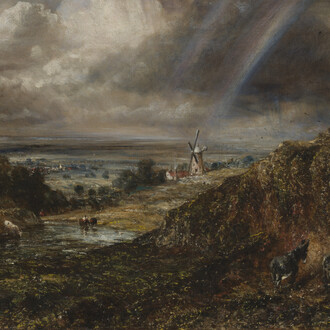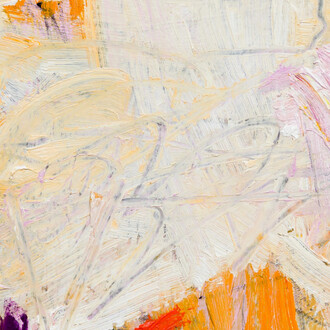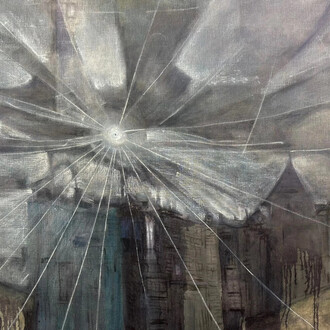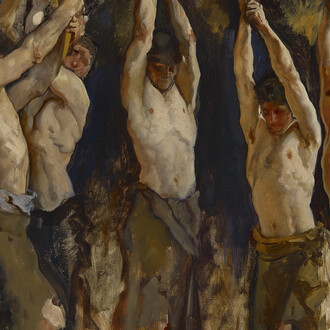Pippy Houldsworth Gallery is delighted to announce Face-to-Face, its third solo exhibition with renowned American artist Mary Kelly (b. 1941). Over the past fifty years, Kelly has been a pioneer of conceptual art and contributed extensively to the discourse of feminism and postmodernism. Running from 20 September to 3 November 2018, the show will comprise works that demonstrate the artist’s sustained engagement with questions of war and violence.
Previously unexhibited collages from the 1960s, new and monumental ‘compressed lint’ works, and unseen studies by the artist for major projects will form the core of the exhibition. Overall, the works will provide a valuable insight into Kelly’s emergence as a project-based artist concerned with social justice before developing these ideas as large-scale, narrative installations. They will also reveal Kelly’s sustained research into major conflicts of recent history, including those in Afghanistan, Yemen, Iraq, Bosnia and Vietnam. Grounded in conceptualism, and informed by psychoanalysis and feminism, the works will elucidate how Kelly has attempted to visualise or voice the inarticulable effect of traumatic events on those affected by war, proposing that coming face-to-face with the ‘other’ is the precondition for both empathy and discourse.
One of the highlights of the exhibition will be Scarcity (1966), a series of collages made while the artist was living in Beirut. On view for the first time, the works are informed by Kelly’s early encounter with the work of Jean-Paul Sartre, drawing particular inspiration from his concept of scarcity as both the foundation of violence and man’s inhumanity to man. Using magazine photographs, coloured paper and pencil in starkly minimal compositions, the collages represent Kelly’s reflections on the Vietnam War as well as the broader context of poverty, imperialism and resistance. The recognition of human vulnerability, which has been an important aspect of Kelly’s work since, is evidenced in her evocative material processes.
Sarajewo 1992 (1999/2018), from the series Mea Culpa, is one of the earliest examples of Kelly’s unique compressed lint technique. Made of rhythmic bands of text, and composed as a sixteen foot relief, the work addresses the traumatic impact of politically-motivated atrocities when received second-hand through the media. The narrative is based on the experiences of Muslim families, forcibly removed from Sarajevo during the Bosnian War, that were reported to The International War Crimes Tribunal. The individual units of lint were cast in the filter screen of a domestic tumble dryer over several months before being assembled as panels of intaglio text. Kelly’s use of lint – ‘the residue of private, domestic and feminized chores’ – speaks to how representations of war filter into everyday life, often overheard on the radio or glimpsed on the news.
The show will also include a new work, Dicere #2 (2018), that looks at the effects of contemporary warfare on the everyday lives of civilians. Similarly made of compressed lint, the work combines the satellite transmission of a drone target with a narrative based on accounts of a US missile attack on a wedding party in Yemen during 2015.
Another highlight of the exhibition, Circa 1940 (2015), refers to an iconic photograph commissioned by Fox Photo Agency during World War II. Recreated on a prodigious scale in compressed lint and projected ‘light noise,’ this work will be the largest and most striking to feature in the exhibition. The image captures the devastation of Holland House Library in the aftermath of a Luftwaffe raid on London, one month after the Blitz began. Three men peruse the bookshelves amidst the rubble, obviously staged as a typically British gesture of defiance. Kelly’s visualisation gives an air of uncertainty to the spectacle, turning attention toward another moment captured in the image described by the artist as the ‘political primal scene’ for her generation. Here, the past is the province of memory and desire, as well as a reservoir of tactics for dealing with the present.
Mary Kelly (b. 1941, Fort Dodge, Iowa) lives and works in Los Angeles. Over the past five decades, Kelly has addressed questions of sexuality, identity and historical memory. Her large-scale narrative installations include Post-Partum Document (1973-79), Interim (1984-89), The Ballad of Kastriot Rexhepi (2001), Circa Trilogy (2004-2015) and Love Songs (2005-07). Kelly first came to prominence with Post-Partum Document, a sociological study of the intersubjective relationship between mother and child. Exhibited in 1976 at the ICA in London, Kelly’s work proved scandalous for incorporating a selection of her son’s stained nappy liners within the installation.
Her work has been the subject of major solo exhibitions at the ICA, London (1976 and 1993); New Museum of Contemporary Art, New York (1990); Generali Foundation, Vienna (1998); Santa Monica Museum of Art (2001); Center for Contemporary Art, Ujazdowski Castle, Warsaw (2008); Moderna Museet, Stockholm (2010); Mary Kelly: Projects, 1973-2010, Whitworth Art Gallery, Manchester (2011); Pippy Houldsworth Gallery, London (2014) and Mitchell-Innes & Nash, New York (2017). Kelly was represented in the 1991 and 2004 Whitney Biennials, Whitney Museum of American Art, New York; Documenta 12, Kassel, 2007, and the 2008 Biennale of Sydney.
Kelly’s work is included in numerous public collections, including Tate, London; Centre Pompidou, Paris; Whitney Museum of American Art, New York; Hammer Museum, Los Angeles; Moderna Museet, Stockholm; MOCA, Los Angeles; Arts Council Collection, UK; Muzeum Sztuki, Łódź; Museum of Contemporary Art, Chicago; Museum of New Zealand Te Papa Tongarewa, Wellington; Whitworth Art Gallery, Manchester; New Museum of Contemporary Art, New York, and numerous others.
In 2017, the Getty Research Institute, Los Angeles, acquired Kelly’s archive. 2018 exhibitions featuring Kelly’s work include those at Whitney Museum of American Art, New York; Kettle’s Yard, Cambridge; Tate St Ives, Cornwall; Pallant House Gallery, Chichester; Murray Edwards College, University of Cambridge; Fitzwilliam Museum, Cambridge, and Tate Britain, London. Kelly is currently making a new, large-scale installation for Desert X, Coachella opening in early 2019.
















